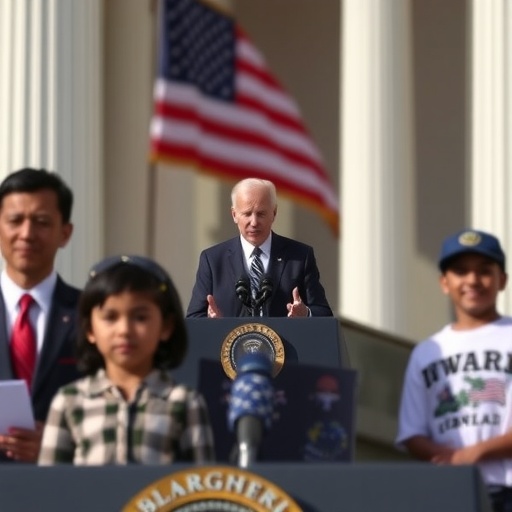Biden Administration Unveils Comprehensive Immigration Reform Plan to Strengthen Border Security and Open Citizenship Pathways
In a bold move amid escalating tensions at the U.S.-Mexico border, the White House has announced a sweeping immigration reform proposal from the Biden administration, designed to fortify border security while creating structured pathways to citizenship for millions of undocumented immigrants. This initiative, detailed in a press conference on Thursday, comes as migrant encounters at the southern border have surged to record levels, with U.S. Customs and Border Protection (CBP) reporting over 2.4 million apprehensions in fiscal year 2023 alone—a 40% increase from the previous year. President Joe Biden emphasized the plan’s dual focus: "securing our borders is not just about walls; it’s about smart, humane policies that respect our nation’s values and address the root causes of migration."
- Breaking Down the Core Elements of the Immigration Reform Proposal
- Fortifying Border Security: From Technology Upgrades to Personnel Boosts
- Unlocking Pathways to Citizenship: Opportunities for Long-Term Residents
- Partisan Fireworks Erupt Over the Proposal’s Viability
- Charting the Path Forward: Legislative Hurdles and Potential Impacts
The proposal, titled the "Secure Borders and Inclusive Future Act," builds on earlier executive actions but marks the administration’s most ambitious legislative push yet. It arrives against a backdrop of fierce partisan divide, with Republicans decrying lax enforcement and Democrats advocating for comprehensive solutions. As border communities strain under the weight of humanitarian crises, this reform could reshape America’s immigration landscape if it gains traction in a polarized Congress.
Breaking Down the Core Elements of the Immigration Reform Proposal
The Biden administration‘s immigration reform plan is a multifaceted blueprint that combines enforcement measures with long-term integration strategies. At its heart are provisions to modernize border infrastructure, including a $10 billion allocation over five years for advanced surveillance technology, such as AI-driven monitoring systems and drone patrols along high-traffic corridors. This investment aims to reduce illegal crossings by 30%, according to internal White House projections, while minimizing the need for physical barriers in environmentally sensitive areas.
Key to the proposal is the expansion of legal immigration channels. The plan introduces a new visa category for agricultural and essential workers, potentially benefiting up to 1.5 million individuals annually. It also streamlines asylum processes by increasing the number of immigration judges from the current 700 to over 1,200 within three years, addressing a backlog that currently exceeds 2 million cases. "We’ve seen families torn apart by endless waits," said Homeland Security Secretary Alejandro Mayorkas during the announcement. "This reform will bring efficiency and fairness to a system that’s been broken for decades."
Statistics underscore the urgency: The Migration Policy Institute estimates that undocumented immigrants contribute $500 billion to the U.S. economy each year through labor and taxes, yet many live in the shadows without access to basic protections. The proposal mandates employer verification programs to curb unauthorized employment, coupled with incentives for businesses to hire legally. These measures are expected to generate 500,000 new jobs in compliance-related sectors, per a preliminary economic analysis from the Brookings Institution.
Fortifying Border Security: From Technology Upgrades to Personnel Boosts
Border security forms the cornerstone of the White House‘s strategy, with the Biden administration pledging unprecedented resources to deter irregular migration. The reform allocates $4.5 billion specifically for hiring 5,000 additional Border Patrol agents and 3,000 customs officers, targeting recruitment from diverse backgrounds to better reflect the communities they serve. This comes as CBP agents have reported burnout rates exceeding 25%, exacerbated by the post-pandemic surge in crossings.
Innovative tech integrations are highlighted as game-changers. The plan includes deploying biometric scanners at ports of entry, which could identify repeat offenders with 99% accuracy, according to Department of Homeland Security (DHS) tests. Partnerships with Mexico and Central American nations are also emphasized, building on the Los Angeles Declaration on Migration to address smuggling networks. "Border security isn’t a partisan issue; it’s a national imperative," President Biden stated, referencing a recent incident where over 10,000 migrants were processed in a single day in El Paso, Texas.
Environmental considerations are woven in, with $1 billion earmarked for sustainable border management, including wildlife corridors that mitigate the impact of enforcement activities on endangered species. Critics from environmental groups like the Sierra Club have praised this aspect, noting that previous wall constructions disrupted habitats for species like the ocelot. However, the proposal faces scrutiny over funding sources, with the administration proposing a mix of reallocated defense budgets and new fees on high-income visa applicants.
- Surveillance Enhancements: 1,000 miles of fiber-optic sensors and AI analytics to predict crossing patterns.
- Personnel Expansion: Training programs for rapid response teams, focusing on non-lethal interventions.
- International Cooperation: Joint task forces with Mexico to dismantle cartel operations, aiming to reduce fentanyl trafficking by 50%.
These elements aim to create a "secure and orderly" border, as described by White House Press Secretary Karine Jean-Pierre, who added that the plan will integrate data-sharing with allies to preempt migration waves driven by climate change and violence.
Unlocking Pathways to Citizenship: Opportunities for Long-Term Residents
One of the most contentious yet hopeful aspects of the immigration reform is its emphasis on citizenship pathways, offering a lifeline to the estimated 11 million undocumented individuals in the U.S. The proposal establishes a 10-year roadmap to legalization for those who arrived before 2010, provided they pass background checks, pay back taxes, and demonstrate community ties. This could extend citizenship eligibility to over 8 million people, including Dreamers and farmworkers protected under prior executive orders.
Under the plan, eligible immigrants would first gain temporary protected status, renewable every two years, before applying for green cards. The Biden administration projects this could boost GDP by 1.5% over a decade, drawing on studies from the Congressional Budget Office that link immigrant integration to economic growth. "These are our neighbors, our workers, our contributors to society," said Senate Majority Leader Chuck Schumer, a key Democratic supporter. "Denying them citizenship only perpetuates inequality."
Family reunification gets a boost too, with provisions to expedite visas for spouses and children separated by years-long waits. The reform also addresses DACA recipients, proposing permanent legislative protection and a fast-track to citizenship for the 600,000 young adults currently in limbo. Advocacy groups like United We Dream have hailed it as "a historic step forward," though they call for broader inclusion of recent arrivals.
- Eligibility Criteria: Continuous U.S. residency for 10+ years, no serious criminal record.
- Application Process: Online portal with fee waivers for low-income applicants, reducing processing times to under six months.
- Economic Integration: English language and civics classes funded through community colleges, targeting 2 million enrollees.
Challenges remain, including concerns over public charge rules that could disqualify those reliant on certain benefits. Nonetheless, the White House envisions this as a bridge to full participation, allowing recipients to vote, own homes, and access higher education without fear of deportation.
Partisan Fireworks Erupt Over the Proposal’s Viability
The announcement has ignited a firestorm of reactions, highlighting the deep partisan chasm in Washington. Republicans, led by House Speaker Kevin McCarthy, have labeled the immigration reform a "amnesty giveaway" that rewards lawbreakers at the expense of American workers. "This isn’t reform; it’s surrender," McCarthy tweeted, vowing to block the bill unless it prioritizes "walls over words." Conservative think tanks like the Heritage Foundation argue that enhanced border security measures fall short, citing a need for mandatory E-Verify nationwide and stricter asylum standards.
On the Democratic side, progressives applaud the citizenship provisions but push for even more ambitious changes, such as decriminalizing border crossings entirely. Representative Pramila Jayapal, chair of the Congressional Progressive Caucus, stated, "While this is a strong start, we must go further to protect all vulnerable migrants fleeing persecution." Bipartisan voices, including moderate Senator Kyrsten Sinema, express cautious optimism, suggesting amendments to balance enforcement with humanitarian aid.
Public opinion polls reflect the divide: A recent Pew Research Center survey shows 60% of Americans support pathways to citizenship, but only 45% favor increased border funding without corresponding legal reforms. Border state governors, from Texas’ Greg Abbott to California’s Gavin Newsom, have weighed in, with Abbott deploying National Guard troops in protest and Newsom offering state resources for implementation.
Stakeholder input has been robust, with over 500 public comments submitted during the drafting phase. Business leaders from the U.S. Chamber of Commerce endorse the plan for its workforce stabilization potential, while labor unions like the AFL-CIO caution against undercutting wage protections. This mosaic of perspectives underscores the proposal’s high stakes in an election year.
Charting the Path Forward: Legislative Hurdles and Potential Impacts
As the Biden administration submits the "Secure Borders and Inclusive Future Act" to Congress, the road ahead is fraught with obstacles. With a slim Democratic majority in the Senate, the bill requires 60 votes to overcome a filibuster, necessitating Republican buy-in that’s anything but guaranteed. House passage could hinge on negotiations over funding, with fiscal conservatives demanding offsets from unrelated programs.
Looking ahead, experts predict a multi-phase rollout even if approved: Initial border security enhancements could launch within 18 months, while citizenship applications might not peak until 2026. The White House is mobilizing a grassroots campaign, partnering with faith-based organizations and NGOs to build support in swing districts. "This is about our future as a nation of immigrants," Biden remarked, invoking the legacy of Ellis Island.
If enacted, the reform could reduce unauthorized immigration by 25%, per DHS models, while adding $1.2 trillion to the economy through integrated workers. Failures, however, risk escalating humanitarian crises, with projections of 3 million crossings in 2024 absent intervention. International ramifications loom large, as success might inspire similar policies in Europe amid its own migration challenges. Ultimately, this proposal tests America’s commitment to balancing security with compassion in an era of global upheaval.
In the coming weeks, congressional hearings will dissect the plan’s finer points, from cost-benefit analyses to enforcement metrics. As debates rage, one thing is clear: The immigration reform battle will define the Biden administration‘s legacy on border security and citizenship.









